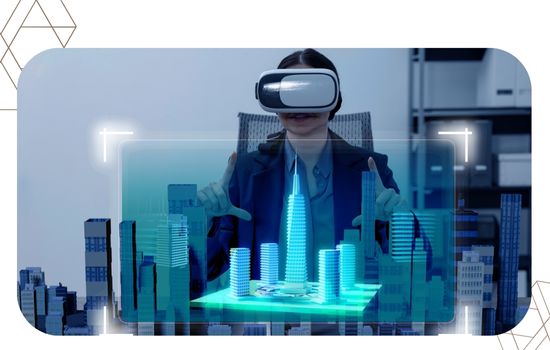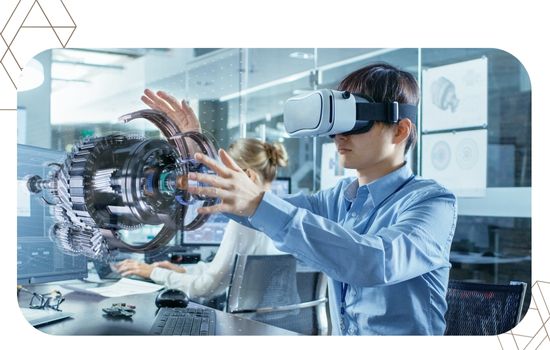Advertisements
The Differences between virtual, augmented and mixed reality They mark the border between three technologies that are transforming the way we perceive the digital world.

Although often confused, each offers unique experiences that change how we interact with entertainment, education, and work.
In the following lines, you'll discover their characteristics, concrete examples, and why these innovations represent the future of human interaction with technology.
Summary:
- What is virtual reality?
- What makes augmented reality different?
- What mixed reality brings
- Current examples and real applications
- Statistics and global overview
- Future challenges and opportunities
- Conclusion and FAQs
Virtual reality: total immersion in a digital environment
Virtual reality (VR) is a technology that completely immerses the user in a three-dimensional digital environment, created using software and viewed with headsets such as Meta Quest 3, HTC Vive or PlayStation VR2.
Unlike other technologies, VR replaces physical reality with a simulated one, where the user can move, interact and experience as if they were inside a video game or a movie.
Advertisements
The impact of VR is especially felt in the entertainment, medical training and architecture.
In education, universities such as UNAM and MIT use it for immersive simulations in medicine and design, reducing costs and improving spatial understanding.
A concrete example: a Mexican virtual tourism company allows users to “visit” archaeological sites like Teotihuacán without physically traveling.
This experience does not replace reality, but expands the possibilities of knowledge and cultural exploration.
Augmented Reality: Integrating the Digital into the Physical
While VR creates alternate worlds, augmented reality (AR) adds digital layers over the physical environment.
It involves seeing the real world enriched with information, images, or virtual elements through a mobile device or smart glasses.
An iconic case is Pokémon GO, which revolutionized the way we interact with public spaces by combining geolocation with the projection of digital characters.
However, AR has extended far beyond entertainment: today it is present in education, medicine, industry and interactive advertising.
Brands use it to offer more engaging shopping experiences.
For example, IKEA allows you to visualize how a piece of furniture will look in your home before purchasing it.
In this way, AR turns decision-making into a personalized and immersive experience.
Mixed Reality: The Bridge Between the Two Worlds
The mixed reality (MR) combines the best of AR and VR.
Instead of just superimposing digital objects or creating fictional worlds, MR integrates both environments in an interactive and coherent manner.
Virtual elements can respond to the physical environment and vice versa.
This technology relies on advanced sensors, depth cameras, and artificial intelligence algorithms that recognize space in real time.
For example, with Microsoft HoloLens 2, an engineer can manipulate 3D models while observing the physical environment and collaborate with colleagues in real time, even if they are thousands of miles away.
MR represents an intermediate point where the user does not disconnect from the world, but It expands it with useful, manipulable and contextualized information.
Comparison table: Key differences between AR, VR, and MR
| Feature | Virtual Reality | Augmented Reality | Mixed Reality |
|---|---|---|---|
| Around | 100 % digital | Combine physical and digital | Interactive fusion between both |
| Device | VR glasses or viewers | Smartphone or AR glasses | Hybrid devices (HoloLens, Magic Leap) |
| Immersion level | Total | Partial | Dynamic and interactive |
| Interaction | Controllers or sensors | Touch screen or camera | Direct manipulation of virtual objects |
| Main applications | Video games, education, simulation | Marketing, medicine, design | Industry, engineering, remote collaboration |

Read more: History of the first video games
The current impact and the data that supports its growth
The rise of these technologies is no coincidence.
According to a report by Statista (2024), the global AR, VR and MR market reached a value exceeding $90 billion dollars, and is expected to exceed by 2028 $200 billion driven by entertainment, education and medicine.
This growth responds to people's desire for more sensory, participatory, and personalized experiences.
In simple words: It's no longer enough to look at a screen; we want to be inside it..
An analogy to understand the differences
Imagine three ways to travel:
- With the virtual reality, you step into a plane that takes you to a whole new world.
- With the augmented realityYou look out the window of your house and see digital information projected onto the landscape.
- And with the mixed reality, you open the window and you can touch a digital cloud that responds to your movement.
This analogy summarizes the Differences between virtual, augmented and mixed reality, showing that each one responds to a different level of interaction and presence.
Example 1: Immersive education
In Mexico, some private universities integrate VR programs to train nursing students.
Simulations allow you to practice medical procedures without real risk, building confidence and precision.
This shows that technology not only entertains: it also forms and prepares for real life.
Example 2: Futures Trading
Luxury fashion retailers are experimenting with mixed reality to allow customers to “try on” clothes without actually dressing.
Using body sensors, the customer sees how a garment would fit in an interactive digital mirror.
The result is a personalized experience that combines the practical with the emotional.
Challenges of mass adoption
Despite the enthusiasm, the adoption of these technologies faces significant barriers:
- High cost of the most advanced devices.
- Need for stable connectivity (5G or higher).
- Lack of standardization on platforms and content.
- Ethical and privacy aspects, especially in facial recognition and biometric data management.
The good news is that advances in chip miniaturization and competition among tech giants are reducing costs and improving accessibility.
Towards 2030: Convergence with Artificial Intelligence
The next evolution will come from the hand of the generative artificial intelligence.
In the near future, systems will be able to create virtual environments tailored to the user's emotional state or the purpose of the session.
The boundaries between the three realities will tend to blur, giving way to an immersive ecosystem where technology will adapt to the human context.
Could there come a time when the line between physical and digital disappears completely?
That is the big question guiding global technological research today.
Conclusion: Beyond the Screens
Understanding the Differences between virtual, augmented and mixed reality It's not just a technical exercise; it's about understanding the direction of the digital future.
Each offers a different level of immersion, interaction and purpose.
The key is knowing which one to apply depending on the objective: educate, entertain, collaborate, or create.
These technologies do not seek to replace reality, but expand it, connecting human emotions with digital environments and turning imagination into experience.
Read more: Augmented and virtual reality: the future of entertainment
Frequently Asked Questions
1. What is the main difference between the three realities?
VR creates complete digital worlds, AR overlays information onto the real environment, and MR combines the two in an interactive way.
2. Which sectors are leading its adoption?
Entertainment, education, health, tourism and e-commerce.
3. Does mixed reality require special devices?
Yes, it requires hardware with advanced sensors, such as HoloLens or Magic Leap, that recognize physical space and project digital elements.
4. Are they safe technologies?
Yes, as long as they're used sparingly and with certified devices. Manufacturers invest in visual protection and data privacy.
5. Which has the greatest growth potential?
MR, for integrating the two worlds and enabling remote collaboration, simulations, and high-value interactive experiences.
In summary: the Differences between virtual, augmented and mixed reality They reflect three complementary paths toward the same destination: a more natural relationship between humans and technology.
Understanding them today means preparing for a future where imagination and reality merge in a conscious, ethical, and deeply human way.



